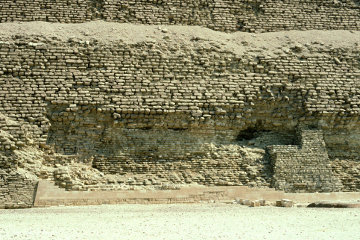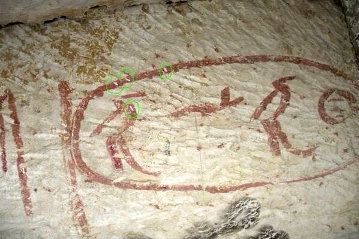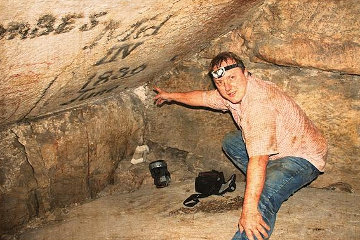Khufu's Vandal
In a case that has hitherto escaped much notice in the press, nine people have been sentenced to five years in prison by an Egyptian court. Their crime? Stealing rock samples from the Great Pyramid and damaging the only reference to the builder of the pyramid, Pharaoh Khufu. Unfortunately, three of the men sentenced are Germans who have left the country and are unlikely to return. As Egypt has no extradition treaty with Germany the chances of them ending up in an Egyptian prison seem small - which is a pity.
One of the Germans is a man called Dominique Görlitz, a school teacher of biology and a self-described "experimental archaeologist". The claim is thought to relate to his attempt to sail a reed boat across the Atlantic in 2006. After fifty-six days at sea the craft broke up and sank, having covered a mere 2,400 miles. Unlike Thor Heyrdahl's attempt with a papyrus boat, Görlitz's craft was based on the reed boats that sail on Lake Titicaca rather than on Egyptian papyrus. In addition he headed east, from New York to Spain as opposed to Heyrdahl's westward voyage.
It never seems to have occurred to Mr Görlitz to wonder exactly what these Aymara Indians were doing, trekking all the way from Lake Titicaca, 12,500 feet up in the Andes in South America, down to sea level in New England, with bundles of reeds on their backs, in order to sail to Spain. Indeed, according to Mr Görlitz, people "regularly" crossed the Atlantic to trade goods, this despite the fact that neither side knew of the other's existence.
We can, therefore, sum up Mr Görlitz as a man who believes that Bronze Age (or earlier) people were capable of astonishing feats of ship-construction and navigation. It is a little surprising, therefore, to find that he is suddenly filled with doubts about the capabilities of Bronze Age people when it comes to pyramid construction. Quite who did build the pyramids is not clear, the odds are apparently about even between little green men from Mars or the inhabitants of Atlantis, and this "truth" is being covered up by an evil archaeological establishment determined to prevent us knowing about the aforesaid little green men from Atlantis.

| |
| Fallen masonry in the Step Pyramid reveals the internal details of its construction. |
Pyramid building came to Egypt in the Third Dynasty when the architectual genius Imhotep built a massive mastaba at Saqqara for his master, Pharaoh Djoser. Having built one mastaba Imhotep decided to improve on things by building another slightly smaller one on top of the first and then, by a process of addition clearly evidenced in the building, he ended up with a pyramid of six steps - the Step Pyramid of Saqqara.
The next pharaoh did the same but then his architect had the bright idea of filling in the steps to make a smooth slope and lo, the genuine pyramid emerged in a clear process of one step leading to another. (The pun is deliberate.) The fact that it was very much a matter of trial and error is shown by Pharaoh Sneferu, whose first pyramid collapsed (the pyramid of Meidum) and whose second had to be drastically lowered when cracks developed in the structure (the Bent Pyramid). He ended up building a third pyramid with such a low angle that it simply couldn't collapse - the Red Pyramid.
The Great Pyramid of Gizeh is thus not an actus mirabilis, a miraculous freak appearing out of the vacuum, but merely a continuation of a process that is taken to its extreme in the Great Pyramid. In fact, some of the details of the construction of the Great Pyramid are clearly based on the earlier pyramids.
Inscriptions on the other pyramids of Gizeh or their associated mortuary temples tell us the names of the pharaohs for whom they were constructed, but the only clue to the builder of the Great Pyramid is a bit of graffiti on a stone that was never intended to see the light of day. Above the King's Chamber is a series of small cavities which, from their supposed purpose, are known as "relieving chambers". The idea is that they would serve to take some of the weight of the enormous pyramid off the ceiling of the King's Chamber. The roof of each chamber is made of the floor of the chamber above until you reach the topmost chamber, which has a pitched roof.
The lowest chamber was accessed via a small opening high in the right-hand wall of the Grand Gallery. The existence of the next chamber was discovered when someone poked a reed up through a crack in the stones and encountered empty space, but there was no entrance to it until Colonel Vyse used gunpowder to blast his way up to it and then, feeling that he was onto a good thing, continued to use explosives until he reached the topmost chamber. As each chamber was discovered, it was named after someone Vyse wished to honour; from bottom to top they are Davison's Chamber, Wellington's Chamber, Nelson's Chamber, Lady Arbuthnot's Chamber, and Campbell's Chamber.

| |
| A recent photograph of the Khufu graffitum. Görlitz is alleged to have scraped away some of the red paint. |
Because the chambers were not intended to be viewed or visited, the stones were not finished in any way and as a result a piece of graffiti on one of the stones in Campbell's Chamber has survived. Marked on the stone in red paint is a crude cartouche in which is written the name of Khufu. It is believed that it was the name of a work gang who used this method to identify the stones for which they were responsible and for which they should be paid.
If Görlitz was hoping that scraping off some of this read paint would prove that the Great Pyramid is several thousand years older than archaeologists believe, he is deluding himself. Pharaoh Khufu is a well-attested pharaoh of the Fourth Dynasty - as are Khafre and Menkaure, the builders of the other two pyramids on the Gizeh plateau - and though there is dispute about the exact dates of these early pharaohs (we ourselves would wish to date them some six centuries later), no one seriously thinks they should be two or more millennia earlier. Görlitz' most likely aim was to try and prove that the graffitum was done with modern paint by Vyse or one of the dreaded archaeological mafia who stand in the way of earnest seekers after truth(!), rather than with ancient paint by Khufu's workmen.

| |
| Mr Görlitz points to the Khufu graffitum in the corner of Campbell's Chamber, which he was shortly to vandalise. |
It is not exactly clear, either, how Görlitz obtained access to Campbell's Chamber. It is not something you can slip into after distracting your guide for an instant! You would need a ladder 30' long and as it would not be possible to carry something that long into the pyramid, it would have to be brought in sections and then assembled in place, after which you would climb up it and wriggle your way into the narrow tunnel leading to the lowest chamber, leaving the ladder behind for the next tour party to encounter.
Unfortunately, even in the days when tourists flocked to Egypt, the guards of the various sites were all too easy to bribe. We never paid money to do something illegal, but on occasion we found it expedient to pass over a few notes to be allowed to do something which an avaricious guard had forbidden on the spur of the moment in hopes of some bucksheesh.
It has to be said, however, that the larger and more important the site, the less likely it was that bribery would be called for or accepted. For Görlitz and his companions to be allowed into the site after hours, carrying not only a ladder but lighting equipment and cameras, we are not talking about one corrupt guard but about a complete shift of guards. It is no surprise, therefore, to learn that the Egyptian police are looking into the activities of Zahi Hawass, formerly head of Egyptian Antiquities Service and before that Director of the Gizeh Area. Zahi, of course, indignantly denies any involvement, but a) he would say that, wouldn't he; and b) Zahi's previous career shows a man who would do anything for a chance to stand in front of a camera.
Görlitz claims that he had a serious scholarly aim in mind when he did his bit of vandalism and states that the scraping of paint he stole has been submitted to the Fresenius Institute in Dresden for analysis. The Institute confirms that they are examining a "sample": they issued a statement saying that "We are currently conducting mineralogical investigations of the samples that Erdmann [Görlitz colleague] brought us. Where they come from we do not know."
Unfortunately for his claims, Görlitz is not a recognised Egyptologist, has submitted no research proposals to the Egyptian government - or anyone else - and does not, as far as anyone knows, have any plans to publish his results in a reputable scientific or archaeological journal. At best he hopes to make a film about his exploits, but his attempt at crowd-sourcing the funding for his film has failed and the attempt has been abandoned.
Görlitz real motivation is his desire to prove that the ancient Egyptians did not build the Great Pyramid. On his website he claims, "Despite this examination, which shall clarify the age of the (cartouche), the amazing differences between the pyramids of Giza and other Egyptian buildings are shown. You will see that builders must have used hi-tech to achieve the remarkable amount of precision and that the size and position of the pyramids are no coincidence but planned according to astronomical orbs."
The reference to "astronomical orbs" appears to indicate that Görlitz buys into the Orion Mystery popularised by another conspiracy theorist, Robert Bauval, and in fact some have claimed that Bauval was involved in Görlitz' actions. Bauval himself furiously denies this in his blog and provides copies of his correspondence with Görlitz. Although I have no time for Bauval and his nutty theories, it does appear that he is telling the truth in his blog.
What lessons can we learn from all this? Well, the first is that if you want to do serious archaeological research you need better qualifications than the ability to survive the mid-Atlantic shipwreck of your reed raft. A degree - if that is what he has - in biology does not qualify one to pontificate on pharaohs and pyramids. Görlitz needs to go back to school, study archaeology or Egyptology (or both) and then submit a proper research proposal to the Egyptian authorities, who are by no means averse to anything that will provoke interest in their country and its history, so long as it is reputable and serious.
Secondly, if you wish to be taken seriously, you have to look at all the evidence, not just one little discrepancy (if discrepancy there be). Even if Görlitz could prove that the graffitum was done in Dulux's finest acrylic, his claim that the pyramid is vastly older than anything else in Egypt would not be advanced one iota. The fact that the Great Pyramid is clearly the end product of a chain of developments from mastaba to Step Pyramid to true pyramid to Great Pyramid, means that it fits very neatly exactly where Egyptologists place it and becomes a startling anomaly if it is put several thousand years earlier.
That is why our belief that the Exodus occurred at the beginning of Middle Bronze is always presented in tentative terms. We are sure that Middle Bronze is where the Exodus fits, but whether that requires that the Biblical chronology is extended backwards in time or Egyptian chronology should be shortened by six centuries (or some combination of the two) requires much more study and investigation before a definite pronouncement can be made.
Finally, if Görlitz was a man, he would go back to Egypt and accept the blame for what he did and exonerate his Egyptian dupes who, thanks to him, are facing five years in gaol - an Egyptian gaol. I sincerely hope that he cannot sleep at night, but I gravely doubt that he feels any guilt at all. He needs to remember, however, that whether you attribute it to God or karma or merely the malignancy of fate, what we do to others very often comes back to haunt us.
sail to Spain Due to prevailing winds and currents it would not be practicable to sail eastwards from any point further south than the New England states of North America, unless you were hoping to land in South Africa. Return
neither side knew This may seem a somewhat sweeping assertion, but I base it confidently on the following consideration. Genetic studies show that people entered the Americas via the Bering Strait and moved southwards into South America. There is no indication that primitive people understood that the world was round, so if by any chance there was a folk memory of this migration, they would naturally seek to sail west, not east, in order to return to their homeland. Likewise, if word of the successful settlement of the Americas did somehow percolate back to Egypt, the Egyptians would have sailed east, not west, to reach their distant relatives. Return
mastaba Named after the low mud bench outside many old Egyptian homes, where people could sit in the cool of the evening and watch the world go by, a mastaba is basically a reconstruction of an ancient Egyptian house, in many cases complete with all the rooms you would expect, plus a staircase to the roof! A deep shaft inside the mastaba led down to the burial chamber and a false door gave the dear departed a method by which he could return to his "House of Eternity" and enjoy the food offerings brought to him and participate in the activities depicted on the walls. Return
Pharaoh Sneferu This outline of events follows the theory developed by German engineer Kurt Mendellsohn and which is now widely accepted, though the precise details are still a matter of discussion. Return
Marked on the stone Unfortunately, during the First World War these relieving chambers were a popular destination for young soldiers eager to explore the pyramid. They had no scruples about leaving their names on the stones, so the graffitum left by the "Khufu Gang" is all but hidden behind the banal names of nobodies, both male and female. Return

| |
| These two objects are on display in the British Museum, despite Robert Bauval claiming that they had mysteriously disappeared. |
have no time Quite apart from the difficulties with his theory that the pyramids of Egypt were laid out to represent the constellation Orion, one of the evidences he cites to prove that there is a conspiracy of archaeologists to suppress the truth is the "disappearance" of two objects found in one of the "air shafts" in the Queen's Chamber - a black basalt ball and a curious bronze object. These had mysteriously vanished and were no doubt being put to malign uses by the Masons or the Trilaterals or the CIA or someone. The only trouble was that shortly before reading the book, I had spotted - and photographed - the objects in a glass case in the British Museum! Return
© Kendall K. Down 2014





